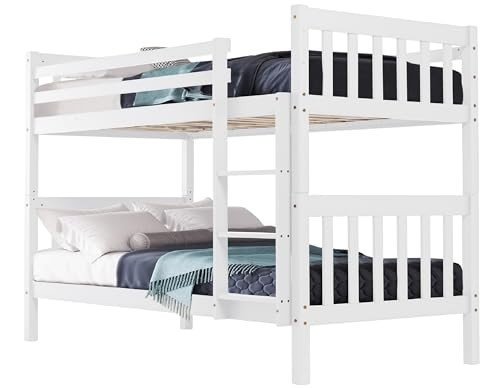The Ultimate Guide to Bunk Beds for Children: Safety, Styles, and Benefits
When it comes to styling a kid's room, parents typically face the dual obstacle of optimizing space while making sure convenience and performance. Bunk beds have emerged as a popular solution that addresses these requirements, providing not simply sleeping arrangements but also adding to a room's aesthetic. In this thorough guide, we will look into different elements of kids's bunk beds on sale beds, concentrating on their advantages, safety functions, styles, and factors to consider for moms and dads contemplating this purchase.
Tabulation
- Benefits of Bunk Beds
- Safety Features to Consider
- Kinds Of Bunk Beds
- Style and Style Options
- Maintenance Tips
- Often Asked Questions (FAQs)
1. Advantages of Bunk Beds
Bunk beds provide many advantages for children and their moms and dads. Here are some essential advantages:
Space-Efficiency: Bunk beds are an outstanding option for smaller sized spaces. By stacking one bed on top of another, more flooring space is offered for play, storage, or research study locations.
Affordable: When children share rooms, bunk beds can reduce the requirement for buying 2 separate beds, therefore saving money.
Promotes Social Interaction: Bunk beds can help siblings or good friends bond by sharing a space, developing chances for social advancement.
Enjoyable Factor: The principle of sleeping "up high" adds a spirited aspect to bedtime, making the transition to sleeping alone much easier for some kids.
Versatile Design: Bunk beds come in numerous styles, colors, and creates to match any space theme, permitting modification that shows the child's character.
2. Safety Features to Consider
Security is vital when it comes to children's furniture, particularly when it comes to adult bunk bed beds. Here are some vital security functions to evaluate:
| Safety Feature | Description |
|---|---|
| Durable Construction | Frames made of solid wood or metal are chosen. |
| Guardrails | Should be at least 5 inches high and extend along both sides of the upper bunk. |
| Ladder Design | Make sure ladders are safely attached and have non-slip steps. |
| Mattress Size & & Fit | Must fit snugly within the frame to avoid gaps. |
| Weight Limit | Always comply with the producer's weight limitation suggestions. |
3. Types of Bunk Beds
Bunk beds are available in several styles, catering to different needs, choices, and space sizes. Here are some common types:
Standard Bunk Bed: The a lot of standard type, with one bed on top of another.
Loft Bed: Features a high upper bed with space beneath for a desk or play area.
Futon Bunk Bed: Combines a top bunk with a futon on the bottom, supplying flexibility for seating and sleeping.
L-Shaped adult bunk bed Bed: This style has the top bunk Beds children's set at a perpendicular angle to the bottom, creating a small corner area.
Triple Bunk Bed: Accommodates three kids using stacked beds, ideal for big households or slumber parties.
4. Design and Style Options
When it pertains to choosing a design for children's bunk beds, the options are practically unlimited. Here are some popular designs:
Traditional Style: Often made of wood, these bunk beds feature elaborate details and are perfect for classic or rustic-themed rooms.
Modern Style: Characterized by tidy lines and minimalist designs, modern-day bunk beds can be made of metal or wood.
Themed Bunk Beds: Some brand names use bunk beds formed like castles, cars and trucks, or play houses, making bedtime less of a chore.
Convertible Bunk Beds: These can be separated into two individual beds, using versatility as kids grow.
Colorful Options: Bunk beds in lively colors can include a sense of pleasure and playfulness to any room.
5. Upkeep Tips
Maintaining a bunk bed bunk for sale is important for durability and security. Here are some pointers:
Regular Inspections: Check for loose screws or bolts every few months and tighten them as required.
Cleaning up: Wipe down frames regularly to avoid dust accumulation; think about utilizing a vacuum for hard-to-reach areas.
Mattress Care: Rotate mattresses regularly and use protective covers to extend their life.
Look for Wear and Tear: Look for any indications of damage in the wood or metal and consider changing parts if required.
Teach Kids Safety Rules: Encourage children to use ladders correctly and guarantee they understand the safety features of their bed.
6. Often Asked Questions (FAQs)
Q1: What age is appropriate for sleeping in a top bunk?
A1: Typically, kids aged 6 and older are recommended for upper bunk sleeping, as they have the necessary motor abilities to climb securely.
Q2: Do bunk beds include a bed mattress?
A2: Most bunk beds are sold as frames only, so you will require to buy bed mattress independently. Make sure that the bed mattress fits the frame snugly.
Q3: Can bunk beds be separated later?
A3: Many styles allow conversion into 2 specific beds, providing flexibility for future needs.
Q4: How can I guarantee my kid's safety on a bunk bed?
A4: Comply with security standards and ensure guardrails, a durable frame, and a protected ladder remain in place.
Q5: Are there weight limits on bunk beds?
A5: Yes, always check the producer's requirements regarding weight limits to make sure safety.

Bunk beds for kids bunk bed can serve multiple purposes while guaranteeing safety and style. With diverse styles and designs available on the market, parents can find a system that not just maximizes bedroom space however also shows their kid's unique tastes. As with any furniture, comprehending security features, maintenance, and how they suit a child's way of life will make sure that these beds remain a useful furnishings service for many years to come.
Through careful consideration and adherence to safety standards, bunk beds can provide a lasting, fun, and practical sleeping option that children like.



